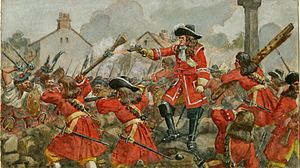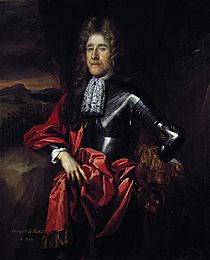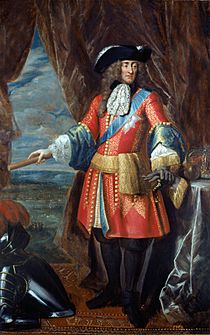Jacobite rising of 1689 facts for kids
Quick facts for kids Jacobite rising of 1689 |
|||||||
|---|---|---|---|---|---|---|---|
| Part of the Jacobite risings and the Glorious Revolution | |||||||
 The Battle of Dunkeld |
|||||||
|
|||||||
| Belligerents | |||||||
| Commanders and leaders | |||||||
| Hugh Mackay Thomas Livingstone |
Viscount Dundee † Ewen Cameron of Lochiel Alexander Cannon Thomas Buchan |
||||||
| Strength | |||||||
| 5,000 – 10,000 (maximum) | 4,000 – 5,000 (maximum) | ||||||
| Casualties and losses | |||||||
| 2,000 – 2,500 (estimate) | 1,500 – 2,000 (estimate) | ||||||
The Jacobite rising of 1689 was a big fight mostly in the Scottish Highlands. Its main goal was to put King James II & VII back on the throne. He had been removed from power during the Glorious Revolution in November 1688.
The name "Jacobite" comes from "Jacobus," which is the Latin word for James. His supporters were called 'Jacobites'. This uprising in 1689 was the first of many rebellions. These fights tried to bring the House of Stuart family back to power. They continued until the late 1700s.
This Scottish revolt was part of a bigger war in Europe called the Nine Years' War. It was meant to help the Williamite War in Ireland from 1689 to 1691. The Jacobites won a big battle at Killiecrankie in July 1689. But their brave leader, John Graham, 1st Viscount Dundee, was killed.
Because their leader died and they didn't get much help, the uprising never really threatened the new rulers. These were William II & III and Mary II. The main fighting ended at Cromdale in May 1690. But the Highlands were not fully controlled until 1692, after the sad Massacre of Glencoe.
Contents
Why the Uprising Happened
In February 1685, James II & VII became king. Many people in England, Scotland, and Ireland supported him. This was true even though he was Catholic.
In Ireland, which was mostly Catholic, people hoped he would give back land. This land had been taken from Catholics in the 1600s. They also wanted him to remove laws that stopped Catholics from holding public jobs.
In England and Scotland, most people were Protestant. They remembered the Wars of the Three Kingdoms from 1638 to 1651. Many feared another civil war if James was not king. This wish for peace quickly ended two Protestant uprisings in June 1685. These were the Monmouth Rebellion in England and Argyll's Rising in Scotland.
In 1681, Scottish laws said people had to obey the king, no matter their religion. In return, James promised to support the Church of Scotland, also called the kirk. By 1680, over 95% of Scots were part of the kirk. Catholics were less than 2% of the people. Other Protestant groups were also not allowed.
James tried to change the Scottish laws. This upset his moderate supporters. It also helped the Presbyterians who had fought against him in 1685. People started to think James was ignoring his promises. This made his position in Scotland much weaker.
In October 1685, about 200,000 French Protestants were forced to leave their homes. This happened because of the Edict of Fontainebleau. Also, King Louis XIV of France was expanding his power. This threatened the Protestant Dutch Republic. Scotland had strong ties with other Calvinists in France and Holland. This made people fear that Catholic countries were threatening Protestant Europe.
Key Events Leading to Conflict
Two things turned this disagreement into a big problem. First, James's son, James Francis Edward Stuart, was born on June 10. This son would become king before James's Protestant daughter, Mary, and her husband, William of Orange. This meant a Catholic king could rule for a long time, not just a short time.
Second, seven bishops were put on trial. This seemed like an attack on the Church of England. It also seemed to threaten the Scottish kirk. The bishops were found not guilty on June 30. This destroyed James's power in both Scotland and England.
Before 1685, many feared a civil war if James was removed. By 1688, it seemed that removing him was the only way to prevent one. France was getting ready for a new attack against the Dutch Republic. William of Orange wanted to make sure England would help him, or at least not fight against him.
In July, an "Invitation to William" was sent. It promised support for William if he brought an army. Many English politicians, even those who had supported James, signed it. The Nine Years War started in September. On November 5, William landed in Brixham with 14,000 soldiers. As he moved forward, many of the king's soldiers left. James went into exile on December 23. In February, the Parliament of England made William and Mary joint rulers of England.
The Scottish Convention

In March 1689, elections were held for a Scottish Convention. This meeting was to decide how Scotland would be ruled. Many of William's advisors were Scots who had been exiled. These included Argyll and Melville. They wanted to remove bishops from the kirk.
When the Convention met in March, there were 125 delegates. About 75 were Presbyterians and 50 were Episcopalians. Only a few were loyal to James. The real arguments were about who controlled the kirk and how much power the king had.
On March 12, James landed in Ireland. He sent a letter to the Convention. It was read on March 16. In it, he demanded that they obey him and threatened to punish them if they didn't. This made people angry. Some Episcopalians stopped coming to meetings, saying they feared for their safety. Others changed sides.
Also, the Catholic Duke of Gordon held Edinburgh Castle for James. His former military leader, Viscount Dundee, started gathering soldiers. This made the Presbyterian group in the Convention stronger. They met in secret, guarded by their own troops.
On April 11, the Convention declared that James was no longer king. They passed the Articles of Grievances and the Claim of Right Act. These laws made Parliament the main law-making power in Scotland. On May 11, 1689, William and Mary accepted the Scottish throne. The Convention then became a full Parliament on June 5.
The Jacobite Uprising Begins
Dundee's uprising was meant to help the Jacobite attack in Ulster. But he did not have enough supplies to keep fighting without outside help. Against him was the very experienced general Hugh Mackay. Mackay had about 3,500 soldiers. This included 1,100 men from the skilled Dutch Scots Brigade.
Ewen Cameron of Lochiel gathered about 1,800 Highland fighters at Glenroy. Dundee joined him with about 40 friends. On May 18, they marched out to try and fight Mackay.
Mackay knew that Highland warfare was usually short. So he avoided fighting. When Dundee returned to Glenroy in late June, most of the clan members went home. This left him with fewer than 200 men. His situation got worse when Gordon surrendered Edinburgh Castle on June 14. Also, the Jacobites' retreat from Ulster made it very hard to get new supplies.
The only help Dundee received was 300 Irish soldiers. They were led by Alexander Cannon. They landed near Duart Castle on July 21.
The Battle of Killiecrankie
Before going back to Glenroy, Dundee put Jacobite soldiers in Blair Castle. This was a very important place that controlled the way into the Scottish Lowlands. It was the home of the Marquess of Atholl. This shows how many Scots tried to support both sides.
Atholl went to Bath, Somerset saying he was sick. Meanwhile, his oldest son, John Murray, pretended to attack his family home for the government. He was careful not to damage it. The castle's soldiers were led by Patrick Stewart of Ballechin. He was a trusted family friend of Atholl.
When Dundee's soldiers arrived at Blair on July 25, Murray left. Mackay also left Perth with about 3,500 men. He moved north to help Murray. At Killiecrankie on July 27, the Jacobites won a huge victory. They caused nearly 2,000 casualties for Mackay's army. But almost a third of their own army was killed, including Dundee.
Cannon took command. But without tools to attack castles, he could not capture a port. This made getting supplies almost impossible. Also, they had no cavalry, which made his Highland soldiers easy targets in open areas. Time was on Mackay's side, as long as he avoided another surprise attack.
After an attack on Dunkeld in August was stopped with many losses, Cannon ended the fighting for the year. His army broke up. Mackay spent the winter taking over Jacobite strongholds. He also built a new base at Fort William. Bad weather caused serious food shortages across the Highlands.
Thomas Buchan replaced Cannon in February 1690. But he could only gather about 800 men. He was surprised at Cromdale in May, and his forces scattered. Mackay chased Buchan into Aberdeenshire. This stopped him from setting up a safe base. In November 1690, Mackay gave command to Thomas Livingstone.
The End of the Uprising
The government wanted to use its soldiers for the war against France. So, in March 1690, Lord Stair offered the Jacobite chiefs £12,000. This money was for them to promise loyalty to William. They finally agreed in June 1691 with the Declaration of Achallader.
However, the war did not officially end until the Massacre of Glencoe in February 1692. Cannon and Buchan had been hidden in the Highlands by Glengarry. As part of the peace deal, they were allowed to go safely to France in March 1692.
What Happened Next
William wanted to keep bishops in the church. But the uprising showed how much he relied on Presbyterian support. To try and save the Episcopalian church, Scottish bishops suggested joining with England. But the English Parliament said no.
In October 1690, the General Assembly of the Church of Scotland met for the first time since 1653. The 1690 Settlement removed bishops from the church. It also created two groups to remove ministers who did not agree. Over the next 25 years, almost two-thirds of all ministers were removed.
Later laws in 1693 and 1695 allowed many of these ministers to return to the kirk. Others were protected by local nobles. For example, Michael Fraser, a minister at Daviot and Dunlichty, started in 1673. He was still working when he died in 1726. This was true even though he was removed in 1694 and joined the 1715 and 1719 Jacobite Risings.
However, a large part of the Scottish upper class stayed outside the kirk. They eventually formed the Scottish Episcopal Church. This church was officially allowed in 1711 by the Scottish Episcopalians Act 1711. It was especially strong in Aberdeenshire and Perthshire. This church would be a major source of Jacobite support in later uprisings.



